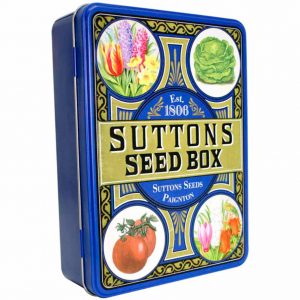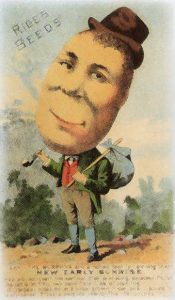In this article on storing collected seeds and the viability (life) of stored seeds, Canadian author Gloria Logan draws on her experience as a long time seed-saver and grower of heirloom varieties in her garden.
 Storing Collected Seeds
Storing Collected Seeds
To store seeds for next year, most important is that all seeds be thoroughly dry and all chaff (waste) removed.
Larger seeds like corn, beans, peas, squash, melons, etc need more drying time than appears. Allow an extra two weeks in open, non-humid conditions before storing them away. It takes only a few, not quite dry seeds to cause the rest to mold in storage.
Once dry, place each variety in its own little paper bag or envelope and label with variety and year saved, and source if other than your own. If you’re unsure of dryness, avoid plastic-type bags which don’t breathe and encourage rot. If you’re sure your seeds are dry, the small zipper storage bags are fine.
Then store the packets in a tin with a lid or a large jar with a lid, and again, label the contents. Desiccants are highly recommended such as the little silica gel bags found in shoe boxes, new handbags, etc, or simply add some dry, uncooked rice or a bit of milk powder to each closed container. These further ensure no moisture problems.
The containers then need to stay in an area out of sunlight (which can heat the container contents) and which is constantly cool but won’t freeze or become hot. Around 10 degrees C is recommended.
Seed Viability Decreases with Time
As it is, seed viability (life) decreases over time, but poor storage conditions greatly shorten viability so dryness of seeds and storage container as well as a constant, cool storage area ensure success.
On the opposite side, many roses are grafted onto wild rootstock simply to give better vigour to the otherwise less hardy flowering end. Look for grafting bumps near the stalk base of fruit trees and roses
Garlic seed is simply the garlic head, which at planting time is separated into cloves and planted. A flowering stalk (scape) will produce tiny bulblets at the expense of the root bulb. The bulblets need three years to produce useful sized bulbs.
Potatoes
 Potatoes do put out a flowering seed head, useful mostly to breeders developing new varieties. Home growers can simply save the best and not too large of their potato tubers for future seed. About hen’s egg size is ideal. These grow as ‘fingers’ from the ‘mother’ which rots when done.
Potatoes do put out a flowering seed head, useful mostly to breeders developing new varieties. Home growers can simply save the best and not too large of their potato tubers for future seed. About hen’s egg size is ideal. These grow as ‘fingers’ from the ‘mother’ which rots when done.
With roots like potatoes, it’s important that you not grow from the same ancestors for more than 5 years, otherwise you also propagate ground diseases like scab, heart rot, blight, etc.
Find another grower you trust with the same variety and swap tubers saved for seed. Most importantly, never grow potato seeds in the same ground space for more than a year; always use a 4 year rotation.
Not only is this for good seed/crop health, this is most important if you grow varieties no one else does. Certified seed growers avoid disease problems by growing at high altitudes where almost no diseases can survive and there are no aphids to spread disease, hence Scottish Certified Seed Potatoes
Dahlias
Dahlias put out both viable seeds as well as tubers which need to be stored indoors for winter in cold areas. Gladioli put out new ‘seeds’ from the original corm which then dies off. Lift the plant for winter, twist off the dead ‘mother’ corm and dry the new youngsters for storage in slightly damp peat moss or coir. All tubers and corms need constant cool, dark storage.
Approximate Viability for Home Saved Seed
If you can store your seeds well, consider the approximate life times for viability:
- 1 Year : onion, parsley, parsnip, salsify, some lettuce
- 2 Years : sweet corn, pepper, okra, leek
- 3 Years : asparagus, bean, broccoli, carrot, celery, kohlrabi, spinach, pea, lettuce
- 4 Years : beet, brussel sprout, cabbage, cauliflower, chard, chicory, eggplant, fennel, kale, mustard, pumpkin, rutabaga (swede), squash, tomato, turnip, watermelon
- 5 Years : collards, cucumber, endive, muskmelon, radish
These are not absolutes, merely approximates. Some seeds simply weren’t viable at the start. Some seeds degrade during storage, faster still if the storage conditions were poor. For the best success, collect fresh seed every year and mark carefully.
Saving your own seed is a satisfying joy as well as a responsibility to future generations who might otherwise miss this opportunity to sample and treasure what we enjoy today.
Seed Saving Articles, Information & Resources
- Freezing and Cold Storing Seeds for Long Term Storage
- Saving Your Own Seeds – General Guide to Seed Saving
- Seed Saving to Improve Biodiversity
- Seed Storage & Longevity Lifespan – How Long Seeds Will Keep For
- Seed Germination & Viability Testing
- Seed Saving: Storing Seeds: Seed Viability
- What Are F1 Plants & Seeds: How & Why of F1 Hybrids
- Seed Saving Heirloom or Heritage Seeds
- Seed Saving: Carrots | Save Your Own Carrot Seed
- Seed Saving: Peas | Save Your Own Pea Seed
- Seed Saving: Tomatoes | Save Your Own Tomato Seed



